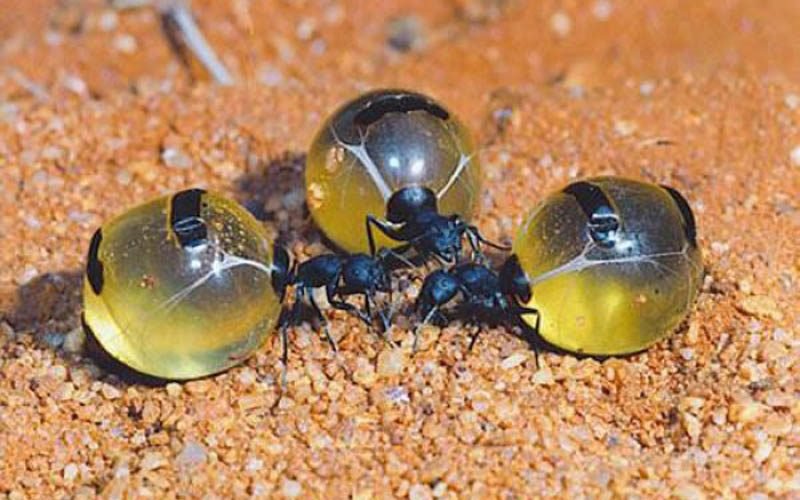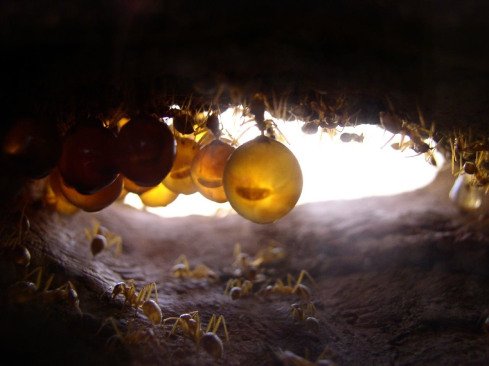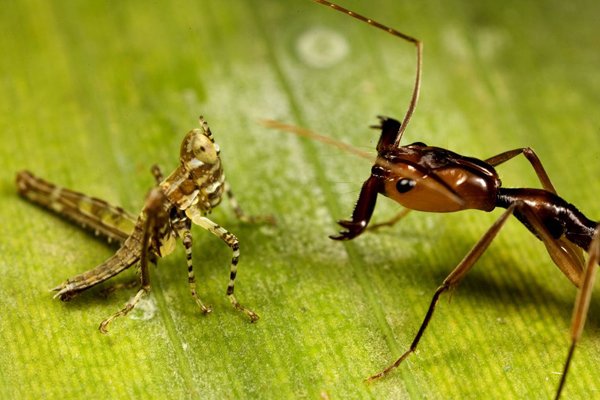God, I love ants, they are definitely one of the most intriguing and complex animal groups for me! However, this post is not about regular ants. I will leave that to @zycr22 who already has done (and continues to do!) a great job covering all the basics you need to know about them.
Instead, in this new mini-series I will share with you some ants that for one reason or the other I think are quite weird.
Update: Click here for Part 2 and here for Part 3
Let's begin:
1# Honey Pot Ants
 (credit)
(credit)
I am sure you know how ants are eusocial animals, divided in castes with each cast having a special role in the colony. The queen is responsible for reproduction, usually being the mother of all other ants. Workers are sterile females that do most of the...work whereas soldiers do some work and also protect the colony from enemies. There are also the "drones", which are the few males that essentially do nothing, other than wait for the right time to have fun with the queen ;)
As for honey pot ants, they are a very special ant cast occurring in about 30 species, and their role is the equivalent to that of a...refrigerator, as they are essentially living storage units!
For the most part of their life, they just feed on the food the workers bring to them. And they eat, eat, eat, eat and then eat some more! Eventually, their abdomens get so swollen that they lose their ability to move!As you can see in the photo, their abdomens look like tiny pots, often the size of a grape, full of "honey" hence the nickname.

Credit: Alexander Maier
Species that have this weird cast are found all over the world in hot and dry areas, like deserts, where water and food become scarce for recurring periods of time. In times of need when resources get limited, honey ants either regurgitate their stored liquid or even sacrifice themselves (this depends on the species) to feed their friends and keep the colony alive!
And yes, in case you wonder, you can eat them! For example, they are an occasional snack for the indigenous Australians who often dig as much as two meters deep to get some on their hands, as you can see in the video down below:
2# The Door Ants

Cephalotes porrasi (credit)
In certain species of the ant genus Cephalotes, for example Cephalotes porrasi, some specialized soldier ants have the weird flattened anatomical adaptation you see in the picture above.
This is because their main role in the colony is to be the....door! Their head seals perfectly the entrances of the tunnels they inhabit and prevents other enemies from entering!
Another interesting fact about Cephalotes is that all species appear to be gliding, meaning that if they are high on a tree and happen to fall or jump, they can glide and steer their fall to land back on it!
 Cephalotes porrasi (credit)
Cephalotes porrasi (credit)
3# The Trap-Jaws

Trap jaw ant (credit)
Species of the genus Odontomachus are best known for their large, straight mandibles capable of opening 180 degrees.
These jaws are locked in place by an internal mechanism and can snap really hard and fast on prey or objects when the tiny hairs on the inside of the jaws are touched. This is why they are commonly known as trap-jaw ants.
One study on the species Odontomachus bauri recorded peak speeds of between 126 and 230 kilometres per hour (78 and 143 mph), making them the animal with the fastest moving predatory appendages! According to the same study, it takes on average only 130 ms for the jaws to close! At their peak, the jaws were recorded to have a force of 300 times the body weight of the ant and an acceleration of 100.000 g (one hundred thousand!!!!!!!!)!
4# The Exploding Ants
 Camponotus saundersi (right) exploding in the face of an attacker (left) (credit)
Camponotus saundersi (right) exploding in the face of an attacker (left) (credit)
The last species I want to share today is Camponotus saundersi, which occurs in Malaysia and Brunei. Interestingly, the workers of C. saundersi have the ability to suicide by explosion when losing a fight against other ants or insects:
Its defensive behaviours include self-destruction by autothysis, a term coined by Maschwitz and Maschwitz (1974). Two oversized, poison-filled mandibular glands run the entire length of the ant's body. When combat takes a turn for the worse, the worker ant violently contracts its abdominal muscles to rupture its gaster at the intersegmental fold, which also bursts the mandibular glands, thereby spraying a sticky secretion in all directions from the anterior region of its head. The glue, which also has corrosive properties and functions as a chemical irritant, can entangle and immobilize all nearby victims. [source]
That's just so freaking cool!
The End (For Now)
That's enough ants for today I think! Stay tuned, there as there are two more parts to come. Do you know of any other weird ones? Don't hesitate to leave them in the comments down below!
More Strange Animals
If you enjoyed reading about this strange creature make sure to check some of my latest posts. I am sure you will love them:
- The Squid With The Human-Like Teeth! (Promachoteuthis sulcus!)
- 4 Very Strange Animals I First Heard Of This Week
- Halloween Special: A Real-Life Monster Compilation
- Alien-Like Moth With Tentacles Terrifies The Internet - But Is This Creature Real?
- This Hummingbird Is Just So Weird! Can You Guess Why?
- This Deep Sea Creature Looks Like An Alien Spaceship
- World's Largest Millipede VS Smallest Millipede
- The Weird Looking Cantor's Giant Softshell Turtle
- 7 Horrifying Micro-Monsters That Will Haunt Your Dreams



